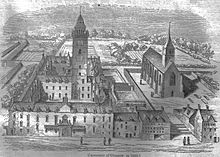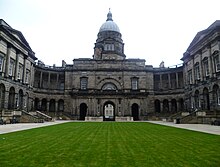History of education in Scotland

The history of education in Scotland in its modern sense of organised and institutional learning, began in the Middle Ages, when Church choir schools and
The Scottish Reformation resulted in major changes to the organisation and nature of education, with the loss of choir schools and the expansion of parish schools, along with the reform and expansion of the Universities. In the seventeenth century, legislation enforced the creation and funding of schools in every parish, often overseen by presbyteries of the local kirk. The existence of this network of schools later led to the growth of the "democratic myth" that poor boys had been able to use this system of education to rise to the top of Scottish society. However, Scotland's University system did help to make it one of the major contributors to the Enlightenment in the 18th century, producing major figures such as David Hume and Adam Smith.
Religious divisions and the impact of industrialisation, migration and immigration disrupted the existing educational system and in the late nineteenth century it was reorganised and expanded to produce a state-funded national system of free basic education and common examinations. The reform of Scottish universities made them major centres of learning and pioneers in the admission of women from 1892. In the 20th century Scottish secondary education expanded, particularly for girls, but the universities began to fall behind those in England and Europe in investment and expansion of numbers. The government of the education system became increasingly centred on Scotland, with the final move of the ministry of education to Edinburgh in 1939. After devolution in 1999 the
Middle Ages

In the Early Middle Ages, Scotland was overwhelmingly an oral society and education was verbal rather than literary. Fuller sources for Ireland of the same period suggest that there may have been
The establishment of Christianity brought Latin to Scotland as a scholarly and written language. Monasteries served as major repositories of knowledge and education, often running schools and providing a small educated elite, who were essential to create and read documents in a largely illiterate society.

Until the fifteenth century, those who wished to attend university had to travel to England or the continent, and just over a 1,000 have been identified as doing so between the twelfth century and 1410.
Impact of the Reformation

The humanist concern with widening education was shared by the Protestant reformers, with a desire for a godly people replacing the aim of having educated citizens. In 1560, the
In 1616 an
The widespread belief in the limited intellectual and moral capacity of women, vied with a desire, intensified after the Reformation, for women to take personal moral responsibility, particularly as wives and mothers. In Protestantism this necessitated an ability to learn and understand the catechism and even to be able to independently read the Bible, but most commentators, even those that tended to encourage the education of girls, thought they should not receive the same academic education as boys. In the lower ranks of society, they benefited from the expansion of the parish schools system that took place after the Reformation, but were usually outnumbered by boys, often taught separately, for a shorter time and to a lower level. They were frequently taught reading, sewing and knitting, but not writing. Female illiteracy rates based on signatures among female servants were around 90 percent, from the late seventeenth to the early eighteenth centuries and perhaps 85 percent for women of all ranks by 1750, compared with 35 per cent for men.[15] Among the nobility there were many educated and cultured women, of which Mary, Queen of Scots is the most obvious example.[16]

After the Reformation, Scotland's universities underwent a series of reforms associated with
Eighteenth century

One of the effects of this extensive network of schools was the growth of the "democratic myth" in the 19th century, which created the widespread belief that many a "lad of pairts" had been able to rise up through the system to take high office and that literacy was much more widespread in Scotland than in neighbouring states, particularly England.
By the eighteenth century many poorer girls were being taught in
In the Scottish Highlands as well as problems of distance and physical isolation, most people spoke Gaelic which few teachers and ministers could understand. Here the Kirk's parish schools were supplemented by the Society in Scotland for Propagating Christian Knowledge, established in 1709. Their aim was to teach English language and end Roman Catholicism associated with rebellious Jacobitism. Though the Gaelic Society schools taught the Bible in Gaelic, the overall effect contributed to the erosion of Highland culture.[28]
Throughout the last part of the century schools and universities also benefitted from the robust educational publishing industry that existed across the Lowlands and which printed primers, dabbity sheets, textbooks, lecture heads and other kinds of effective learning tools that helped students remember information.[29]
In the eighteenth century Scotland's universities went from being small and parochial institutions, largely for the training of clergy and lawyers, to major intellectual centres at the forefront of Scottish identity and life, seen as fundamental to democratic principles and the opportunity for social advancement for the talented.[30] Chairs of medicine were founded at Marsichial College (1700), Glasgow (1713), St. Andrews (1722) and a chair of chemistry and medicine at Edinburgh (1713). It was Edinburgh's medical school, founded in 1732 that came to dominate. By the 1740s it had displaced Leiden as the major centre of medicine in Europe and was a leading centre in the Atlantic world.[31] The universities still had their difficulties. The economic downturn in the mid-century forced the closure of St Leonard's College in St Andrews, whose properties and staff were merged into St Salvator's College to form the United College of St Salvator and St Leonard.[32]

Access to Scottish universities was probably more open than in contemporary England, Germany or France. Attendance was less expensive and the student body more representative of society as a whole.
Many of the key figures of the Scottish Enlightenment were university professors, who developed their ideas in university lectures.
Nineteenth century

Industrialisation, urbanisation and the
At the beginning of the 19th century Scottish universities had no entrance exam, students typically entered at ages of 15 or 16, attended for as little as two years, chose which lectures to attend and left without qualifications. After two commissions of enquiry in 1826 and 1876 and reforming acts of parliament in 1858 and 1889, the curriculum and system of graduation were reformed to meet the needs of the emerging middle classes and the professions. Entrance examinations equivalent to the School Leaving Certificate were introduced and average ages of entry had risen to 17 or 18. Standard patterns of graduation in the arts curriculum offered 3-year ordinary and 4-year honours degrees and separate science faculties were able to move away from the compulsory Latin, Greek and philosophy of the old MA curriculum.[41] The historic University of Glasgow became a leader in British higher education by providing the educational needs of youth from the urban and commercial classes, as well as the upper class. It prepared students for non-commercial careers in government, the law, medicine, education, and the ministry and a smaller group for careers in science and engineering.[42] St Andrews pioneered the admission of women to Scottish universities, creating the Lady Licentiate in Arts (LLA), which proved highly popular. From 1892 Scottish universities could admit and graduate women and the numbers of women at Scottish universities steadily increased until the early 20th century.[43]
Twentieth century

The Scottish education system underwent radical change and expansion in the 20th century. In 1918

The first half of the 20th century saw Scottish universities fall behind those in England and Europe in terms of participation and investment. The decline of traditional industries between the wars undermined recruitment. English universities increased the numbers of students registered between 1924 and 1927 by 19 per cent, but in Scotland the numbers fell, particularly among women. In the same period, while expenditure in English universities rose by 90 per cent, in Scotland the increase was less than a third of that figure.
After devolution, in 1999 the new
The current education system
For a description of the current education system in Scotland, see Education in Scotland
See also
- History of schools in Scotland
- Gaelic medium education in Scotland
- List of further and higher education colleges in Scotland
Notes
- ^ ISBN 0-19-538623-X.
- ^ ISBN 0-521-89088-8, p. 76.
- ISBN 0-7486-1299-8, p. 220.
- ISBN 0-7509-2977-4, p. 128.
- ^ ISBN 1-84384-096-0, pp. 29-30.
- ^ ISBN 1-4464-7563-8, pp. 104-7.
- ^ ISBN 0-7486-0276-3, pp. 68-72.
- ^ ISBN 0-333-56761-7, pp. 124-5.
- ISBN 0-333-56761-7, pp. 119.
- ISBN 0-521-89088-8, p. 5.
- ISBN 0-300-09234-2, pp. 59-62.
- ISBN 0-7486-0276-3, pp. 183-3.
- ^ "School education prior to 1873", Scottish Archive Network, 2010, archived from the original on 28 September 2011.
- ^ ISBN 0-7486-1625-X, pp. 219-28.
- ISBN 0521890888, pp. 63-8.
- ISBN 0748612998, p. 187.
- ^ ISBN 0-7486-0276-3, pp. 183-4.
- ISBN 90-04-10097-0, p. 280.
- ISBN 0-19-162433-0, pp. 196-7.
- ISBN 0140136495, pp. 227-8.
- ISBN 1-4464-7563-8, p. 262.
- ^ ISBN 0-14-100234-4, pp. 91-100.
- ^ ISBN 0-609-80999-7.
- ^ José Manuel Barroso (28 November 2006), "The Scottish enlightenment and the challenges for Europe in the 21st century; climate change and energy", EUROPA: Enlightenment Lecture Series, Edinburgh University, archived from the original on 22 September 2007, retrieved 22 March 2012
- ^ a b c "The Scottish enlightenment and the challenges for Europe in the 21st century; climate change and energy", The New Yorker, 11 October 2004, archived from the original on 6 June 2011
- ISBN 0-7486-1625-X, p. 1022.
- ISBN 1843836815, p. 26.
- ISBN 0521624037, p. 138.
- ^ Eddy, Matthew Daniel (2012). "Natural History, Natural Philosophy and Readership". History of the Book in Scotland. 2: 297–309.
- ^ ISBN 0-19-211696-7, pp. 612-14.
- ISBN 0521003237, p. 100.
- ^ "Medieval university" (PDF). Archived from the original (PDF) on 22 July 2013. Retrieved 3 January 2013.
- ISBN 0-521-89088-8, p. 245.
- ^ M. Magnusson (10 November 2003), "Review of James Buchan, Capital of the Mind: how Edinburgh Changed the World", New Statesman, archived from the original on 6 June 2011.
- ISBN 0-415-06164-4.
- ISBN 0807861138, p. 282.
- ISBN 0-7382-0692-X, pp. 117–43.
- ISBN 1-4464-7563-8, p. 397.
- ISBN 0712698930, p. 403.
- ^ "Education records", National Archive of Scotland, 2006, archived from the original on 31 August 2011.
- ISBN 0-7486-1625-X, p. 224.
- ^ Paul L. Robertson, "The Development of an Urban University: Glasgow, 1860-1914", History of Education Quarterly, Winter 1990, vol. 30 (1), pp. 47-78.
- ISBN 1-86094-986-X, p. 264.
- ^ ISBN 0-7486-0999-7, p. 78.
- ISBN 0-7486-1625-X, pp. 664-5.
- ^ "UHI is awarded taught degree awarding powers, news release 26 June 2008, Highland Council website, accessed 20 March 2009". Highland.gov.uk. 26 June 2008. Archived from the original on 28 July 2011. Retrieved 2 February 2011.
- ISBN 0-7486-1625-X, pp. 132-40.
- ISBN 0-7486-1625-X, pp. 62-73.
Further reading
- Anderson, R. D. Education and the Scottish People, 1750-1918 (1995).
- Anderson, R. D. "The history of Scottish Education pre-1980", in T. G. K. Bryce and W. M. Humes, eds, Scottish Education: Post-Devolution (2nd ed., 2003), pp. 219–28.
- Hendrie, William F. The dominie: a profile of the Scottish headmaster (1997)
- O'Hagan, Francis J. The contribution of the religious orders to education in Glasgow during the period, 1847-1918 (2006), on Catholics
- Raftery, Deirdre, Jane McDermid, and Gareth Elwyn Jones, "Social Change and Education in Ireland, Scotland and Wales: Historiography on Nineteenth-century Schooling," History of Education, July/Sept 2007, Vol. 36 Issue 4/5, pp 447–463
- Smout, T. C. A History of the Scottish People, Fontana Press 1985, ISBN 0-00-686027-3
